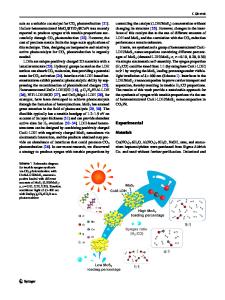Photocatalytic reduction of chlorate in aqueous TiO 2 suspension with hole scavenger under simulated solar light
- PDF / 871,548 Bytes
- 12 Pages / 595.276 x 790.866 pts Page_size
- 20 Downloads / 378 Views
ORIGINAL ARTICLE
Photocatalytic reduction of chlorate in aqueous TiO2 suspension with hole scavenger under simulated solar light Bahngmi Jung 1 & Fatima Abu-Rub 1 & Abdellatif El-Ghenymy 1 & Wei Deng 2 & Ying Li 2 & Bill Batchelor 3 & Ahmed Abdel-Wahab 1,3 Received: 15 July 2020 / Accepted: 17 November 2020 # Qatar University and Springer Nature Switzerland AG 2020
Abstract This work investigates photocatalytic reduction of aqueous chlorate by using commercial P25 TiO2 in the presence of hole scavengers under simulated solar light. It compares the photocatalytic ability of P25 TiO2 to reduce chlorate in the presence or absence of a hole scavenger (methanol) with that of bismuth oxyhalides (BiOBr, TiO2-BiOBr, BiOCl, TiO2-BiOCl, and BiOI). Bismuth oxyhalides have more interest as promising photocatalysts because they have a narrow band gap and are more responsive to visible light. However, in this study, P25 TiO2 was a more effective photocatalyst for chlorate reduction in the presence of methanol than bismuth oxyhalides. Also, this study examines the effectiveness of methanol, ethanol, and formate as hole scavengers during chlorate reduction. The presence of methanol enhanced chlorate reduction more than that of formate and ethanol. Finally, this work estimates the impacts of operating parameters such as photocatalyst dose, initial chlorate concentration, solution pH, methanol concentration, and light intensity on chlorate removal and studies the reaction mechanism for chlorate reduction in the system of TiO2/chlorate/methanol (photocatalyst/contaminant/reagent) under simulated solar light. The highest chlorate removal of 97.5% was achieved using 1 g/L of TiO2 with initial chlorate concentration of 0.012 mM and methanol concentration of 2 mM at the pH of 5.4 after 180 min of radiation. The major product of chlorate photoreduction was chloride ion. Keywords Advanced reduction process . Chlorate . Photocatalytic reduction . Titanium dioxide . Methanol . Hole scavenger
1 Introduction Disinfection is a process of deactivating harmful and objectionable bacteria, viruses, cysts, and other pathogenic microorganisms which spread waterborne diseases [1, 2], and it is an essential process in most drinking water and wastewater treatment systems. Chlorination that involves the addition of chlorine or chlorine-based derivatives is the most commonly used chemical method of disinfection because of its * Bahngmi Jung [email protected] * Ahmed Abdel-Wahab [email protected] 1
Chemical Engineering Program, Texas A&M University at Qatar, PO BOX 23874, Doha, Qatar
2
Department of Mechanical Engineering, Texas A&M University, College Station, TX, USA
3
Department of Civil Engineering, Texas A&M University, College Station, TX, USA
effectiveness against a wide spectrum of disease causing microorganisms, low cost, and high reliability. Although the use of chemical disinfectants is essential to water treatment, it retains some problems. Each of the common disinfectants can produce disinfection by-products (DBPs) that
Data Loading...











